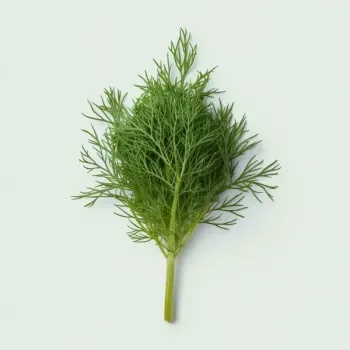Dill and Thyme are distinct herbs used in cooking for their unique flavors; dill is light and sweet, ideal for fish and pickling, while thyme is earthy, great for meats and stews. They differ in taste, aroma, appearance, and culinary use across various cuisines.

Dill is an aromatic herb in the celery family known for its delicate, feathery green leaves and a sweet, grassy flavor. It's often associated with European and Scandinavian cuisines, particularly for pickling and with fish dishes.

Thyme is a Mediterranean herb from the mint family. It has small, pungent leaves and is used for its strong, earthy flavor in a variety of dishes including meats, soups, and stews.
Dill has a fresh, citrus-like taste with a slightly grassy undertone, while thyme offers a more earthy, minty flavor with hints of lemon under certain varieties.
Dill features fine, feathery leaves, whereas thyme leaves are small, round, and grow on woody stems.
Dill is commonly used fresh and is known for its affinity with fish and pickling, while thyme is versatile, used both fresh and dried, and is a staple in Mediterranean, Italian, and French cuisines.
Dill is a staple in Scandinavian and Eastern European cuisines, while thyme has a strong presence in Mediterranean, particularly Greek and Italian, cooking traditions.

Your ultimate Recipe Box, Meal Planner, and Cooking Class all in one
Ideal for salmon gravlax, dill sauce, and shrimp salads. Dill complements the delicate flavors of seafood and enhances freshness. Use sprigs to infuse flavor during poaching or finely chopped in dressings. Perfect for bouillabaisse, baked fish, and seafood stews. Thyme holds up well to lengthy cooking times, releasing complex flavors. Sprinkle leaves on seafood before grilling or roasting.
Used in herbed chicken salads or as a garnish for roasted chicken, providing a bright, refreshing contrast to the rich flavors of poultry. Essential for herbed chicken roasts, stuffing, and in marinades. Thyme's robust nature complements chicken and turkey, particularly well in slow-cooked dishes.
Excellent in broths, potato soups, and cucumber soups. Dill's light flavor profile is best added towards the end of cooking to preserve its delicate taste. A key herb in bouquet garni, used in beef stews, minestrone, and French onion soup. Thyme contributes a subtle depth, infused throughout the cooking process.
Makes a refreshing addition to yogurt-based sauces, tartar sauce, and vinaigrettes. It's best to use dill fresh to avoid overpowering the sauce's flavor balance. Used in rich gravies, tomato sauces, and béchamel. Thyme's potency means a little goes a long way, so it should be used judiciously to avoid dominating the other flavors.
Dill and thyme both offer a range of health benefits and contain various vitamins and minerals, though their nutritional profiles differ slightly.
| Nutrient | Dill ( per 100 grams ) | Thyme ( per 100 grams ) |
|---|---|---|
| Fat | 1.1g | 1.7g |
| Sodium | 61mg | 9mg |
| Calcium | 208mg | 405mg |
| Protein | 3.5g | 5.6g |
| Calories | 43 | 101 |
| Carbohydrates | 7g | 24g |
It's not generally recommended as they have distinct flavors and uses, but it could work in some recipes where the herb is not the main flavor component.
Not usually. Dill is common in European and Scandinavian cuisines, while thyme is a staple in Mediterranean, Italian, and French cooking.
Yes, but the flavor will be less pronounced, so you may need to use more dried dill to achieve the desired taste.
Thyme's flavor intensifies with cooking, making it suitable for dishes with longer cooking times, while dill's flavor is more delicate and should be added at the end of cooking.
While not common, they can be used together in some multi-herb recipes, like certain soups or stews, to create a complex flavor profile.